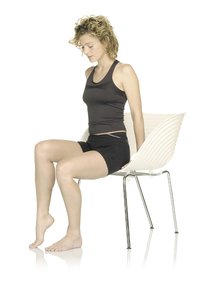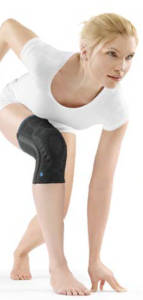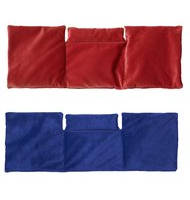Complex Physical Decongestion Therapy
The treatment of lymph- and lipedema
Lymphedema does not cure itself. Should it remain untreated, progressing severity cannot be avoided and extreme swelling of the extremities affected can be the result. Only long-term treatment will make the disease to some extent tolerable for the patient. It is the objective of therapy to reverse edema to a less serious stage. The earlier therapy begins, the more successful it can be. Thus stage I lymphedema can often by keeping to different therapeutic components be reversed to stage 0. But even if started later, usually a clear improvement in the patient´s condition can be achieved.
At the centre of the treatment of lymphedema is Complex Physical Decongestion Therapy (CPD). But it is also used in the treatment of lipedema patients. It brings about a reduction in water retention (edema) typical of the disease and thus leads to both a reduction in size and a reduction in edema related sensitivity to pressure, tension and touch.
Afflicted persons are freed from pain through treatment, especially through therapy with flat knitted made-to-measure medical compression stockings. The fat deposits, however, often can not be reversed by means of Complex Physical Decongestion Therapy. To remove these deposits and thus improve body shape, patients have for some years undergone successfully surgical adipectomy (liposuction).
Complex Physical Decongestion Therapy (CPD)
Here the interplay of several therapeutic measures is essential, which are combined under the concept of Complex Physical Decongestion Therapy (CPD).
Phase I:
This phase serves to relieve and reverse swelling – the so-called decongestion phase.
Depending on the degree of severity, phase I lasts three weeks or even considerably longer.
The patient can undergo treatment as an out-patient or an in-patient. Also this depends on at which stage of lymphedema treatment was started.
Phase II:
The so-called control phase ensures that the decongested condition of the affected extremity is maintained and continues to be optimised. This phase is usually carried out for life. Is the therapy interrupted, this will again result in an increase in edema.
In both phases of Complex Physical Decongestion Therapy (CPD) four therapeutic components are deployed:
- Manual lymph drainage
- Compression therapy
- Hygiene/Skin care
- Gymnastics/motion exercises
- Self-management and clarification
Manual lymph drainage (ML)
Manual lymph drainage is not to be compared with a traditional massage. It helps the congested lymph to be transported in the lymphatic vessels. The application of certain massage techniques stimulates the pulsation of the walls of the lymphatic vessels. In doing so, it is important that not only the affected extremities are treated but also the supplying and returning lymphatic pathways, as the edema is otherwise only shifted. The massage helps increase the flow of lymph in the lymphatic vessels that still function.
Manual lymph drainage always begins in the area of the neck and in the upper quarter of the body, which produces a suction effect on the lower lymphatic vessels. The therapist then shifts edema fluid from edema rich to edema poor areas, pushes it into lymphatic vessels and softens the hardened connective tissue. In phase I manual lymph drainage is carried out once or twice a day and can in phase II be reduced to once or twice a week.
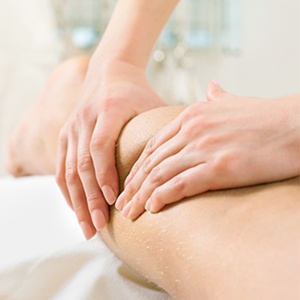
Manual lymph drainage is one of four components of CPD.
Compression therapy
Apart from manual lymph drainage, compression therapy gains in importance in the two phases. The external pressure on tissue applied by compression stockings supports the backflow of lymph from tissue into the lymphatic vessels and veins. Compression therapy is a crucial contributory factor in reducing edema and provides effective prevention against renewed swelling.
A guiding principle in the treatment of lymphedema patients is therefore: No manual lymph drainage without compression therapy!
During the decongestion stage short stretch bandages are used for compression purposes which must be applied immediately following manual lymph drainage to prevent backflow of lymph fluid into the decongested extremity. Compression bandages have the advantage that they can be continuously adapted to the daily changing dimensions of legs or arms.
Bandaging requires a special wrapping technique. The short stretch bandages provide the muscles with firm resistance and aid the drainage of lymph when moving. To avoid causing the patient damage or pain due to bruising or constriction, a trained physician or therapist should apply the compression bandage.
During the control phase medical compression stockings instead of compression bandages are used. They help to maintain the decongestion result on a permanent basis, prevent reedematization and prevent the further development of an edema. In comparison to compression bandages, compression stockings are easier to manage. The patient can change them himself and they are more pleasant to wear. In the case of lymphedema patients the dimensions of afflicted extremities can fluctuate wildly. That explains why stockings are exclusively manufactured as individual flat knitted made-to-measure products. Flat knitted compression stockings have in comparison with round knitted stockings a number of advantages which make them essential in the treatment of lymphedema patients. Read here more about the difference between round and flat knitted stockings.
The proper care of extremity lymphostatic edema with compression stockings is essential for successful long-term therapy. To meet all individual requirements flat knitted compression stockings are available in a vast range of different designs (Stocking, pantyhose, with or without toe, gloves, arm sleeves etc.) The compression applied and the design depend on the severity and the location of the lymphedema as well as the age of the patient.
Hygiene/Skin Care
With lymphedema the skin is also badly affected. There is a tendency for inflammation and wound healing disorder to occur. Erysipelas, in particular, are seen as a frequent complication, which can also worsen the edema.
Additionally, the skin under the compression bandage and the compression stocking can dry out, become flaky or cracked, which is an entry point for pathogen.
Daily skin care is for this reason essential. In the morning and in the evening the affected extremities should be carefully cleaned and adipose and moisturizing lotion put on. It must be ensured that pH neutral products, such as eg Callusan Cream foam are used and are not rubbed too vigorously into the skin.
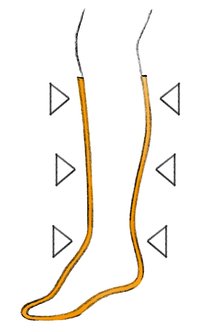
Gymnastics/Motion therapy
Gymnastic decongestion exercises under compression are essential for the lymphedema patient – and are therefore the fourth component of Complex Physical Decongestion Therapy. For only when moving can compression therapy take full effect. Depending on the location of the edema the therapist selects exercises tailored to the needs of the individual.
These motion exercises must be carried out in a conscious and controlled manner and may not under any circumstances inflict pain. The exercises should take place several times per day (approx. two or three times a day). Better often brief exercises than one long one. Besides gymnastic exercises, also Nordic Walking is eg under compression highly suitable for aiding decongestion.
Self-management and clarification
Self-management is seen as an important component that leads to success in therapy and is consequently the connecting component of all CDPT building blocks.
To achieve the desired therapeutic success and also maintain this success on a permanent basis, it is important to carry out Complex Decongestive Physiotherapy with strict determination. But as the name already suggests, it is, however, a complex and time-consuming therapy. Moreover, it is a permanent cycle – the chronic disease demands lifelong treatment and therefore much discipline and motivation.
So as not to lose courage in the face of setbacks, it can be helpful if one has a clear understanding of the therapy’s background and the effectiveness of individual building blocks and can thus judge their importance for success correctly. For this purpose patients must be informed and reasons explained. In addition it seems to make sense to train, besides purely communicating knowledge about edema, also certain techniques, such as skin care, bandaging or decongestive exercises.
A responsible and informed patient is able to organize his or her therapy better and integrate it into daily life. One learns to interpret warning signals and one knows which measures can be taken independently or where one can ask for advice.
